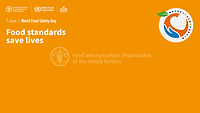World Health Day 2015: A Global Focus on Food Safety

Source: The FDA Voice Blog
Food safety is a public health issue that affects all nations – from the most advanced to the most poor. World Health Day, observed on April 7 each year to mark the anniversary of the 1948 founding of the World Health Organization (WHO), gives us an opportunity to reflect on the progress that has been made to address the need for strong food safety systems, and on the enormous challenges that lie ahead.
The global importance of this issue is reflected in this year’s World Health Day theme: “Food Safety: From Farm to Plate, Keep it Safe.” Keeping food safe, from farm to table, is at the core of our mission as an agency and at the heart of the preventive, risk-focused food safety system envisioned by the FDA Food Safety Modernization Act (FSMA).
We’re not alone in recognizing this critical need. Other countries as well are looking for ways to build preventive, modern food safety systems. Just two weeks ago, my colleagues and I were in India to meet with public health officials, regulators and representatives of industry. We all take the same position on food safety: As nations we must be strong individually and collectively, working in partnership to apply controls as foods increasingly cross multiple borders to reach foreign markets.
The challenges are great, starting with the complexity of a global supply chain in which food sources are far flung. There’s the difficulty of building comparable preventive controls in food systems that can vary widely from nation to nation. There’s also the issue of resources, as nations face financial constraints and competing priorities.
And while we can arrive at the best standards, whether they’re based on FSMA or Codex Alimentarius — a collection of international food safety standards, guidelines and codes of practice — we must find a way to verify that these requirements are being met every day in every country. Rules and regulations alone won’t make foods safe. What matters is how we, as an international community, achieve high rates of compliance with standards that prevent illness.
WHO estimates that each year there are an estimated 2 million deaths worldwide from food and waterborne diseases, including many children. In the United States alone, about 48 million people (1 in 6 Americans) get sick, 128,000 are hospitalized, and 3,000 die each year from foodborne diseases, according to the Centers for Disease Control and Prevention.
To bring these numbers down, WHO helps countries prevent, detect and respond to outbreaks of foodborne disease and we are proud to be its partner in advocating for and educating on food safety. This year, in addition to providing a broad opportunity to look at the roles governments and food producers can play in protecting consumers, World Health Day is also focusing on what individuals can do to protect themselves at home by keeping foods free of contamination.
Today WHO will be engaging people worldwide in a social media conversation about food safety. Use the hashtag #SafeFood to share and learn. There will also be a webcast from 10 a.m. to 10:45 a.m. ET in English, and from 11:15 a.m. to noon in Spanish, with a live Q&A session via Twitter and Facebook, using the hashtags: #SafeFood and #SocialGood.
Join the conversation. As individuals, and as nations, we each have a stake in keeping our food safe.
Michael R. Taylor is FDA’s deputy commissioner for foods and veterinary medicine.
Looking for a reprint of this article?
From high-res PDFs to custom plaques, order your copy today!








